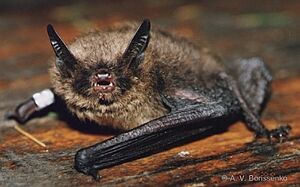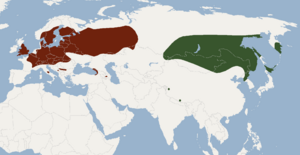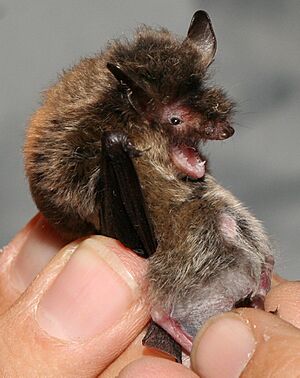Brandt's bat facts for kids
Quick facts for kids Brandt's bat |
|
|---|---|
 |
|
| Conservation status | |
| Scientific classification | |
| Genus: |
Myotis
|
| Species: |
brandtii
|
 |
|
| Myotis brandtii range in red | |
| Synonyms | |
|
|
The Brandt's bat (Myotis brandtii) is a small bat that belongs to a group called vesper bats. These bats are found across most of Europe and parts of western Asia. They are known for their unique features and interesting habits.
Contents
Discovering the Brandt's Bat
This bat was first officially described in 1845 by a German scientist named Eduard Friedrich Eversmann. He gave it its scientific name. For a while, people thought the Brandt's bat was just a type of whiskered bat.
However, in 1958, scientists started to think they might be different species. Later studies in the 1970s confirmed this idea. The bat is named after another German zoologist, Johann Friedrich von Brandt.
Scientists used to think that bats in central and eastern Asia were also Brandt's bats. But newer studies show that these are actually a different species called the Siberian bat.
Where Brandt's Bats Live
Brandt's bats live all over Europe and western Asia. You can find them in places like Great Britain, Western Europe, Central Europe, and parts of Russia. In the Balkans, they mostly live in the mountains.
In 2010, Brandt's bats were even seen in Ireland for the first time! They can live in many different places, from sea level up to about 1,800 meters (about 5,900 feet) high. These bats prefer forests with deciduous trees (trees that lose their leaves) or mixed forests. They also like to be close to water.
What Brandt's Bats Look Like
Brandt's bats have dark gray or brown fur on their backs. Their fur is grayish underneath, and it often has golden tips. Their face and the tips of their ears are a pinkish color.
Brandt's Bat Biology
Just like humans and some other bats, Brandt's bats cannot make their own vitamin C. They need to get it from their food.
Reproduction and Life Cycle
During the summer, female Brandt's bats gather together to form special groups called maternity colonies. This is where they raise their young. A female bat usually has one baby at a time.
Baby bats are born in early summer. They can start flying when they are about one month old. These maternity colonies are often found inside hollow trees or in special bat houses. Some female bats can have babies when they are only three months old, but most wait until they are over a year old. Mating happens in the fall. However, the females store the male's sperm until spring, which is when the baby starts to grow.
How Long Brandt's Bats Live
Scientists once thought Brandt's bats could live for nearly 40 years. But it turns out those very old bats were actually the Siberian bats, which are a different species. Brandt's bats do not live as long as Siberian bats.
Brandt's bats near Saint Petersburg in Russia live for about 8.5 years on average. Those in the Baltic region can live up to 18.5 years. However, scientists have found clues in the Brandt's bat's body that suggest they are built to live a long time. They can also live longer by staying in caves, which protects them from bad weather and animals that might hunt them. Like many bats, they also hibernate (sleep through the winter), which helps them live longer.
Brandt's Bat Senses
Brandt's bats use echolocation to find their food. This means they send out sounds and listen for the echoes to create a picture of their surroundings. Because they rely so much on echolocation, their sense of smell is not as strong.
Their eyes are small and are good for seeing in dim light. They probably cannot see colors very well and might not see clearly in bright daylight. The sounds they use for echolocation are very high-pitched, between 32 and 103 kilohertz. The strongest part of their sound is around 51 kilohertz, and each sound burst lasts about 4.2 milliseconds.
Protecting Brandt's Bats
The IUCN currently lists the Brandt's bat as a species of least concern. This means there are many of them, they are found in many places, and their numbers do not seem to be going down.
Like all bat species in Europe, the Brandt's bat is a European Protected Species. This means it is against the law to purposely catch, kill, hurt, or disturb these bats. Also, the places where they live and raise their young are protected.
Images for kids






